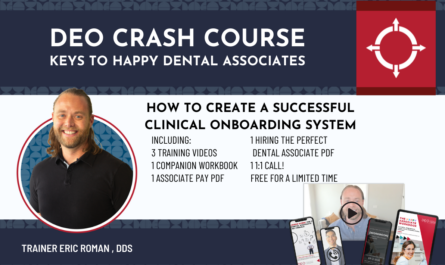How to achieve growth through your current patient base
By Heidi Arndt, RDH, BSDH
Revenue growth by new patients is the focus of most dental practices across the country. According to Dental Economics, dental practices are spending more than a half-billion dollars on marketing each year to attract new patients into their practices.
There is no doubt a new patient brings a high level of revenue growth to the dental practice, and should be a focus for every growing practice. But, what if you could experience more than 40 percent hygiene revenue growth, without relying solely on new patients to fuel your growth?
Subhead: Digging into the details
Most dental offices report their existing patient pool has been completely tapped, and they need new patients in order to fuel revenue growth. While this may be partially true from a restorative standpoint, this is not true when looking from the hygiene perspective.
If you feel your group is struggling to grow hygiene revenue and challenged by the number of new patients you are bringing in, then it is time to dig into the details of your hygiene department. The best place to start is by collecting some data. Start by running a report commonly titled “Procedure by Provider Report” for your hygiene team. This report will show you the variety of services your hygiene team is charging out. There is often a common trend that will stand out to you, and one that we see from practice to practice. Your trend may look a lot like this. (See graphic.)
Existing patients are most commonly charged a prophy or a periodontal maintenance. In some cases this is probably suitable, but in most cases this provides us with a clue that we need to dig into the patient records to see what type of assessments were completed on each patient, and if the correct care was provided for each patient. You will most likely see that 90 percent of the time a comprehensive assessment has not been completed. No comprehensive periodontal assessment, no periodontal risk assessment, and no caries risk assessment. Without those assessments, how can you identify what the patient really needs?
Subhead: Comprehensive assessments
Making assumptions without comprehensive assessment is a costly mistake. You must complete comprehensive assessments on each patient in your practice, regardless if they are new or they have been your patients for the past 20 years. Once you start doing this, you will find your patients have a large amount of needs.
According to the “ADHA: Standards for Clinical Dental Hygiene Practice,” the dental hygienists should provide individualized and comprehensive assessments for every patient in order to provide optimal oral health to every patient.
These key assessments should be included at every appointment, for every patient.
- Patient Medical/Dental History. Understanding each patient’s specific history is important. Both periodontal and caries risk factors can be identified during this assessment. For example, asking patient questions about family history of periodontal disease or caries is important to identify risk. According to the ADA, 30 percent of people are genetically susceptible to periodontal disease. This risk factor needs to be identified during the medical/dental history.
- The Comprehensive Periodontal Assessment is one of the steps that gets overlooked. The comprehensive periodontal assessment includes six-point probing, recession, furcation, mobility, exudate, and bleeding. This information should be collected at each and every dental hygiene appointment and documented in the patient record a minimum of once a year, (although, having this documented at each visit is strongly recommended.) Once the assessment is completed, you must identify and treatment plan accordingly to address the needs of your patients. Remember, just because they are an existing patient does not warrant the “wait and watch” approach. Treat disease when you see it, in order to reduce the long-term affects the patient could experience from the disease.
- Risk Assessment. Building off the comprehensive medical/dental review and the clinical assessment, the risk assessment should be completed on each patient. During this assessment the dental hygienist should identify periodontal and caries risk factors. Based on current science, risk factors are the main driver in the susceptibility of disease. These risk factors can change frequently, thus the need for consistent and thorough assessments of our patients is warranted.
- Caries Risk Assessment: A strong Caries Risk Assessment (CRA) will help you identify if your patient is at low, moderate or high risk for caries. The caries risk is based on previous and current clinical and environment factors. Based on these risk factors, the dental team will recommend preventive measures such as fluoride, sealants, or other antimicrobials for the patients. Without a strong caries risk assessment, your patients will not receive the preventive care they want and deserve.
- Periodontal Risk Assessment: The periodontal risk assessment is also built off of the clinical and environmental risk factors that will be discovered through the assessments listed above. The periodontal risk assessment is crucial to understanding your patients’ potential for periodontal disease, or how they respond to periodontal treatment. It also provides tools to help educate patients about optimal oral health and overall health. Current research is telling us the chronic inflammatory process and the pathogens that cause periodontal disease may contribute to systemic disease.
Don’t assume your existing patient base is “taken care of.” Risk can change daily and the patients oral and overall health can change quickly, as well. Completing a comprehensive assessment on every patient will open up doors for you to provide necessary care to each patient – new or existing.
One additional practice management note: Do not fall in the trap of placing your recall patients onto a 30- to 40-minute hygiene appointment. This appointment length will not allow your hygiene team to complete the necessary assessments, and thus limiting your hygiene team’s growth, and ultimately the growth of doctor revenue too.
Maximize the care of your existing patients by addressing their needs. You will see a true healthy patient base and your revenue will soar!




